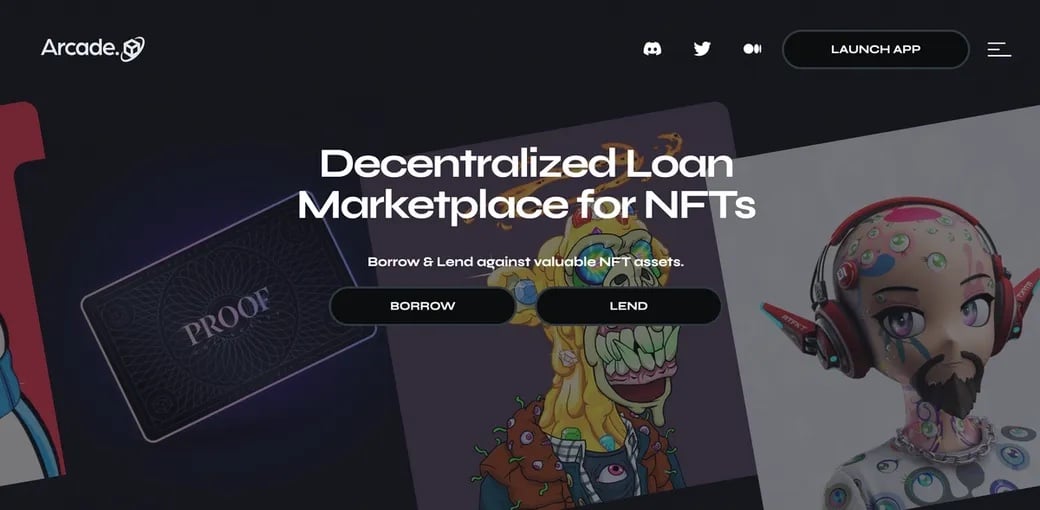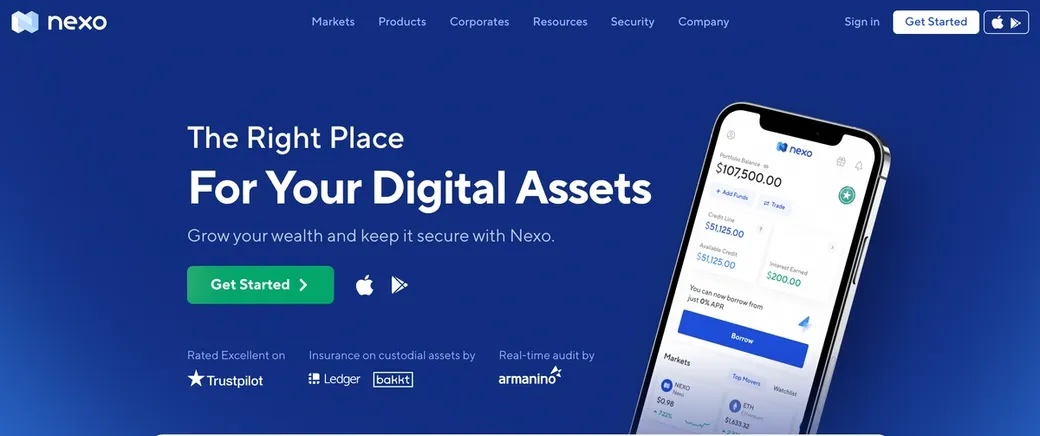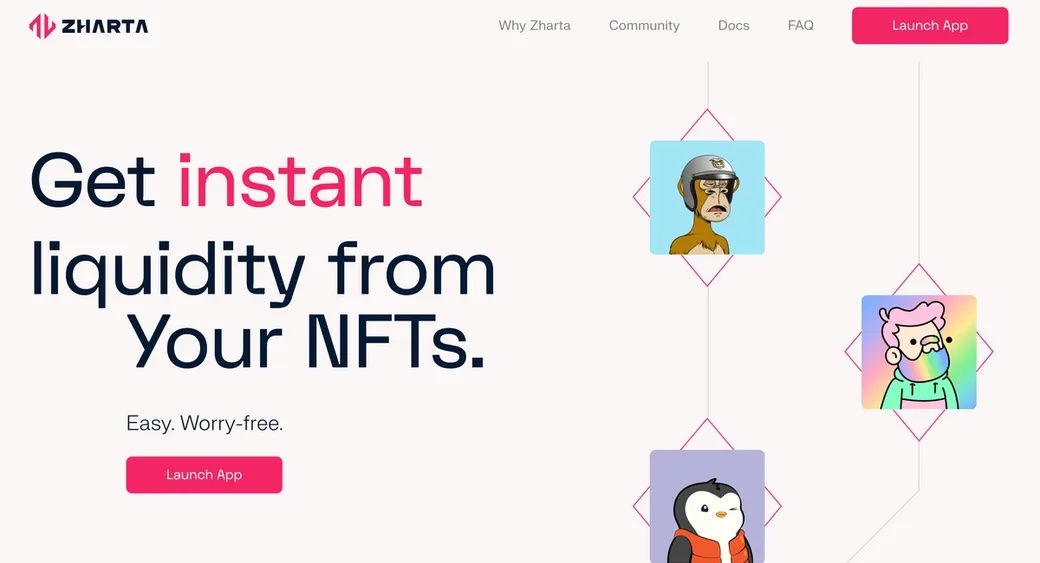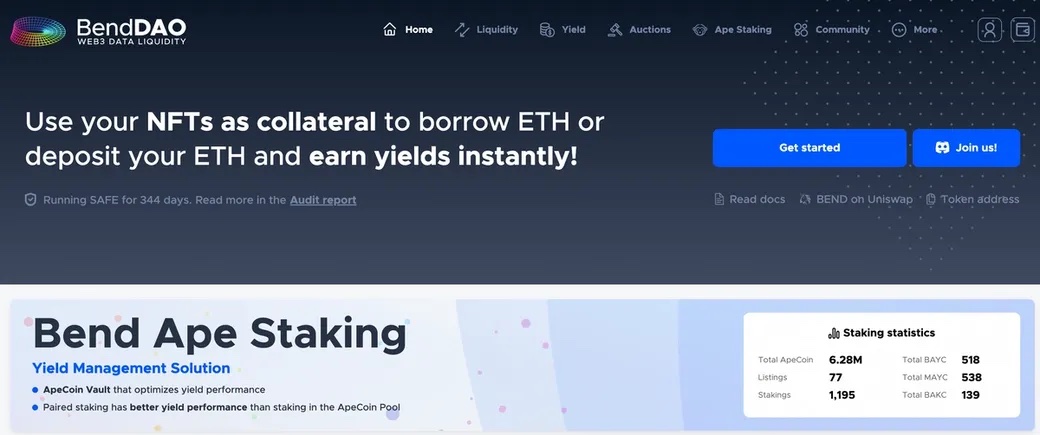Borrowing Against NFTs: NFT Loan Platforms, Pros, Cons, Risks
Borrowing Against NFTs: What Does This Mean?
Borrowing against NFTs refers to NFT owners listing their NFTs as collateral to obtain a crypto or fiat loan from other users. The actual asset — in this case the NFT — is not sold. Rather, the intention is to borrow funds and, in case you can’t pay the lender back, you agree to forfeit the assets you borrowed against as payment.
How Does NFT Lending Work?
NFT lending takes place on an NFT lending platform where borrowers and lenders are matched. The borrower who is choosing to collateralize an asset negotiates with lenders who offer loan agreements. When a lender is chosen, the NFT is transferred into a digital vault that is kept in an escrow smart contract on the blockchain for the duration of the loan.
The loan is then transferred to the borrower and the lender receives interest on the loan. The borrower must repay that loan amount within the time period both people agreed to on the contract. If the loan is not paid on time (defaulted), the lender keeps the NFT at a discounted price.
One great example is when the NFT Bored Ape Yacht Club #8646 was initially purchased for 0.55 ETH and then collateralized for 90 days once its value had gone up significantly. A loan of 45 wETH — a “wrapped” version of ETH that is pegged to ETH’s value — was issued to the owner and in just a few months, the lender would receive 48.3 wETH (30% APR) or the defaulted NFT if the borrower failed to repay the loan.
Pros And Cons Of NFT Lending
 Pros
Pros
- No need to sell your assets
- Immediate cash
- Take advantage of market price fluctuations
 Cons
Cons
- Loss of NFT holder benefits
- Risk losing asset if unable to repay loan
- Lenders can lose money if asset is overvalued
Top NFT Loan Platforms 2023
- NFTfi: Best For Liquidity
- Arcade: Best For Consolidating Multiple NFTs
- Nexo: Best For High-Yield NFTs
- Zharta: Best For Loan Automation
- BenDAO: Best For Peer-To-Protocol
| Platform | Protocol Type | Supported Blockchains | Fees | Notable Collections | Interest Rate | Which Cryptos? |
|---|---|---|---|---|---|---|
| NFTfi | Peer-to-peer | Ethereum | 5% of the interest earned on loans by lenders only | Bored Ape Yacht Club VeeFriends World of Women | 40%-100% APR | wETH or DAI |
| Arcade | Peer-to-peer | Ethereum | No fees | Bored Ape Yacht Club Azuki Meebits | 61.96% APR | wETH or USDC |
| Nexo | Peer-to-peer | Ethereum | Unknown | CryptoPunks Bored Ape Yacht Club | 10%-20% LTV ratio | ETH or stablecoin |
| Zharta | Peer-to-pool | Ethereum | No fees for borrowers, just interest | Bored Ape Yacht Club Crypto Punks VeerFriends World of Women | 25%-50% | ETH |
| BendDAO | Peer-to-protocol | Ethereum | No fees, just 30% default interest | CryptoPunks Bored Ape Yacht Club Azuki | 30%-40% | ETH & $BEND |
1. NFTfi: Best For Liquidity

| NFT Lending | NFT Fractionalization | NFT Derivatives | NFT Renting |
Offering services for over 150 NFT collections, NFTfi is the most widely used and trusted peer-to-peer NFT lending platform. Backed by major investors, borrowers are able to set their desired terms while lenders submit their counteroffers. This platform provides a thorough analysis of the NFTs available for collateral, which helps inspire more trust from the community.
As for price valuation, NFTfi uses the current floor prices, project averages, and a valuation from NFTBank. Borrowers access liquidity they need by receiving wETH and DAI loans via permissionless smart contract infrastructures that cannot be tampered with. NFTfi charges no borrowing fees; however, lenders are charged 5% of the interest earned on successful loans.
2. Arcade: Best For Consolidating Multiple NFTs

| Multiple NFT Wrapping | Peer-To-Peer | Collection-Wide Loan Offers | Borrowing With Or Without Terms |
Arcade — formerly known as Pawn.fi — is another popular peer-to-peer NFT lending platform. But instead of borrowing against just one NFT, users can “wrap” multiple NFTs into one wrapped token that can then be collateralized as a single asset. This means that borrowers can take out much larger loans versus other platforms. Compared to NFTfi, Arcade provides more borrowing flexibility by allowing NFT listings with or without proposed terms.
One major advantage of using this platform is that loans can be repaid at any time and in full. The Arcade platform is the only protocol that lets lenders make collection-wide loan offers, allowing them to reach a broader range of borrowers.
3. Nexo: Best For High-Yield NFTs

| High-yield NFTs | Receive up to 20% of NFT value | Home to one of the biggest NFT-backed loans issued |
Since 2018, Nexo has been a leading lending institution in the digital finance markets. The company currently manages assets for more than 5 million users and is now offering NFT lending services as well. It is known for issuing one of the biggest NFT-backed loans, worth more than $3.3 million.
This platform currently focuses more on high-value NFT collections, but more may be added later. You can earn up to 20% of the value of your CryptoPunk or BAYC, but the value of the NFT has to exceed $500,000. You are assigned an account manager and then sign a lending agreement before receiving your funds.
Please note: Nexo is a centralized platform whose lending and borrowing practices are not disclosed to the public. Notable centralized platforms have become insolvent in the past and have gone bankrupt without returning user assets. It’s important to keep in mind that storing your valuable assets in the custody of a centralized exchange exposes you to this platform risk.
4. Zharta: Best For Loan Automation

| Platform automates loan amounts | Platform chooses best assets to borrow against | Quotes and funds received in real-time |
The Zharta platform will help you in choosing the loan you need by automatically supplying the assets that support how much you wish to obtain.
Alternatively, you can select your assets across a slider grid, and the platform will automatically generate how much you should borrow. If you agree to the terms, you can approve the quote and get your loan in real time. In addition, you can use one or more assets or bundles from the same category to borrow from.
5. BendDAO: Best For Peer-To-Protocol

| Peer-to-protocol | Receive up to 40% of asset’s floor value | bendETH tokens issued to lenders |
BendDAO is the first decentralized peer-to-protocol liquidity platform for NFT lending. A loan pool supported by liquidity providers offers NFT-backed loans with some notable blue-chip NFT collections like BAYC and CryptoPunks being used as collateral. NFT owners can receive loans up to almost 40% of the listing’s value.
The value of assets on these types of platforms is aggregated using blockchain “oracles” — bridges that facilitate information flow from outside a blockchain. Lenders who supply liquidity to these pools receive interest-bearing bendETH tokens.
Who Might Want To Borrow Against Their NFTs?
Borrowing against your NFT gives you the advantage of quickly receiving liquidity. This is because in the NFT marketplace it may take months to sell your asset. The fact that funds are immediate through this method makes NFT lending attractive. The types of people who are more likely to borrow against their NFTs include:
- NFT owners: Those who already own NFTs but don’t want to sell them, knowing more value may accrue over time. So, they borrow against them to invest in more NFTs without losing their assets.
- Avoid a taxable event: NFT loans can be used to access liquidity without creating a taxable event (through selling your NFTs). This is a tax-efficient strategy used by many since the interest payments on borrowing against collateralized NFTs are often lower than the capital gains tax would be if those assets were sold.
- People who need fast cash: This is the major upside to NFT lending. Some people just need money quickly and have a difficult time getting loans elsewhere.
- Play-2-Earn Players: Some players want to generate returns through their P2E games or yield farming so they take out the loan.
Peer-To-Protocol vs. Peer-To-Peer NFT Lending: What’s The Difference?
| Peer-To-Protocol | Auction in case of default | Priced by oracle (bridged data to and from blockchains) | Governance determines loan terms |
|---|---|---|---|
| Peer-To-Peer | Foreclosure in case of default | No price oracle | Peers negotiate loan terms |
Peer-to-peer NFT lending allows users to borrow and lend NFT assets through specialized NFT lending platforms. This method allows for customizable loan terms between peers, but there is also another borrowing method called peer-to-protocol lending which allows users to borrow funds directly from the protocol rather than a single counterparty.
The protocol gathers liquidity from platform users who add their funds to the protocol pool and it then releases these funds as loans whenever borrowers lock up their NFT in the protocol’s digital vault. This escrow solution ensures that, if the borrower cannot meet their loan obligations, the protocol has access to the NFT asset and may liquidate it to cover the outstanding loan.
Another category added to the NFT lending marketplace includes the opportunity to rent out your NFT to others. Just as you would rent out space in an apartment with rental terms and conditions, a renter and an NFT “tenant” would do the same on a smart contract.
During the “tenancy” period, the NFT is transferred from one wallet to the other instead of being locked up in escrow. The tenant then gets to enjoy the perks as if he or she were the actual owner of the NFT. This may include full access to token perks and whitelist giveaways. After the tenancy period, the NFT is returned back to its original owner.
NFT Lending Risks And Safety
NFT lending offers users myriad investment opportunities in the crypto market. However, just as with any other financial endeavor, there will always be risks to consider. In general, lending NFTs is a safe practice provided you use a reputable platform and a heavily-audited smart contract. Without an audit, you risk your NFT or funds being hacked and stolen. Before entering an NFT lending agreement, some risks to consider include:
- Improper valuation: Loans are made according to a mutual agreement on the value of the asset being collateralized. Without a proper value, lenders risk losing money while a borrower risks getting less than they otherwise would for their NFT asset.
- Platform Risk: Centralized platforms that take your NFT collateral into their custody may pose a threat to your valued asset if they disable withdrawals or become insolvent. While this is not a common occurrence, platforms have gone bankrupt in the past without returning client assets, so it’s an important risk to keep in mind.
- Defaulting on the loan: This is the most common risk when borrowing against your NFT. If you can’t pay back the loan you received, you risk losing your asset.
- Market Conditions: The NFT market is volatile. Because of this, lenders risk losing money if the NFT was overvalued or the price plummets.
To Sum It Up
NFT-backed loans and borrowing against your own NFTs are great ways to provide liquidity to the NFT market — a market, which up until this point, was limited to just trading and holding non-fungibles. It could take months for an NFT to get sold, and this is what makes it so illiquid.
Now with NFT lending, both a borrower and a lender can benefit financially in a shorter time frame while simultaneously helping expand the market. A borrower can leverage their collectible value to invest in other ventures, for example, while the lender earns returns on the loan. In sum, borrowing against NFTs just may be the key to revolutionizing the way creators manage their digital assets.
Frequently Asked Questions
Yes. Your NFTs can be used as collateral to secure a loan as long as the borrower and the lender agree on the asset’s value, the interest rate, and the length of the term.
Yes. NFTs are relatively illiquid since bid/ask prices often differ so much that it makes it difficult to sell your NFT for its market value. In addition, collectors don’t always agree on the value, which makes the process slower.
NFT loans are loans offered on a decentralized platform that allows NFT owners to place their NFTs or collections in collateral in exchange for cryptocurrency or fiat.
Peer-to-peer NFT lending is when an NFT owner lists his or her NFT as collateral on an NFT lending platform in order to receive loan offers from others on the platform. Once an offer is accepted, the borrower receives crypto or fiat from the lender’s wallet, and the NFT is stored in an escrow smart contract.